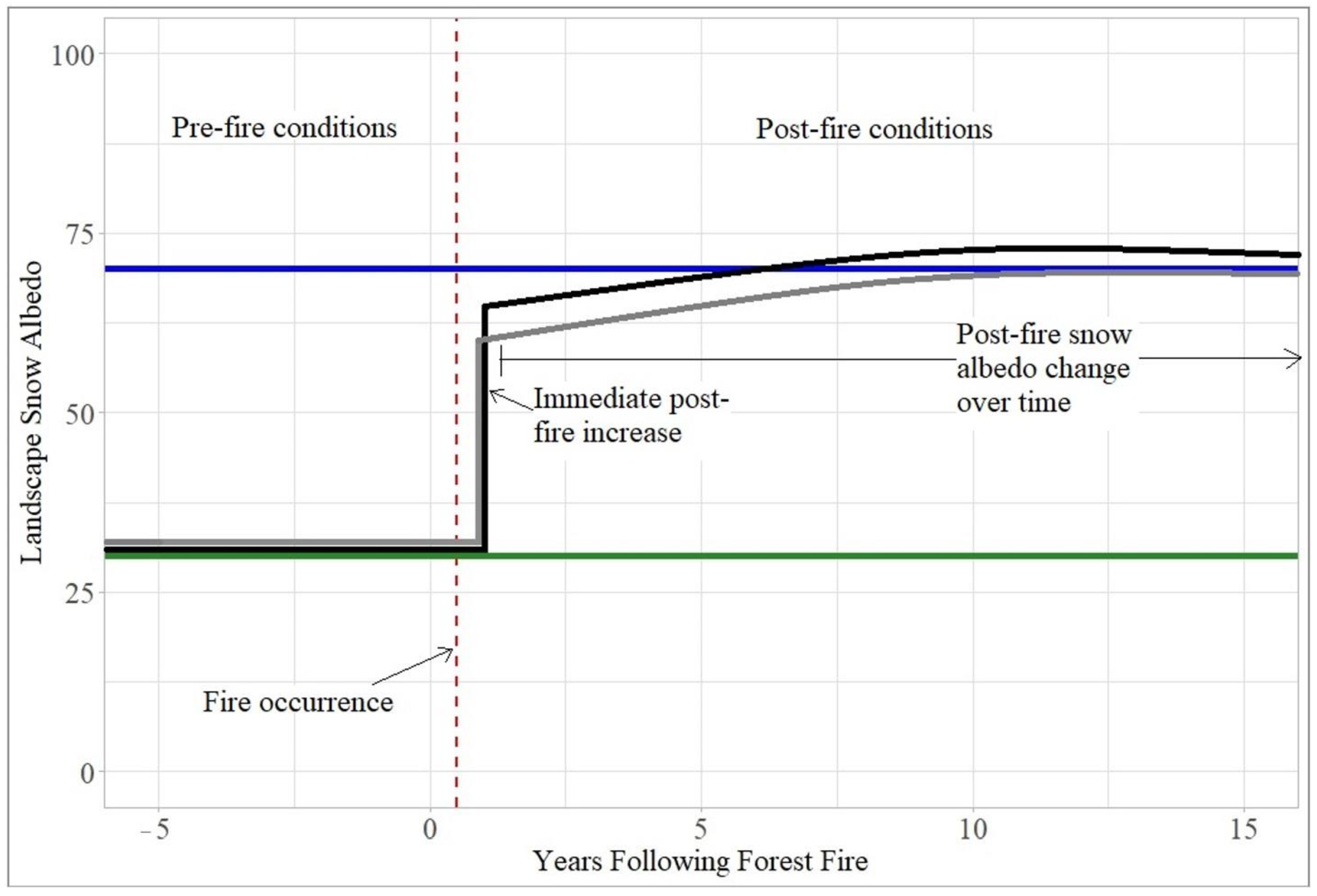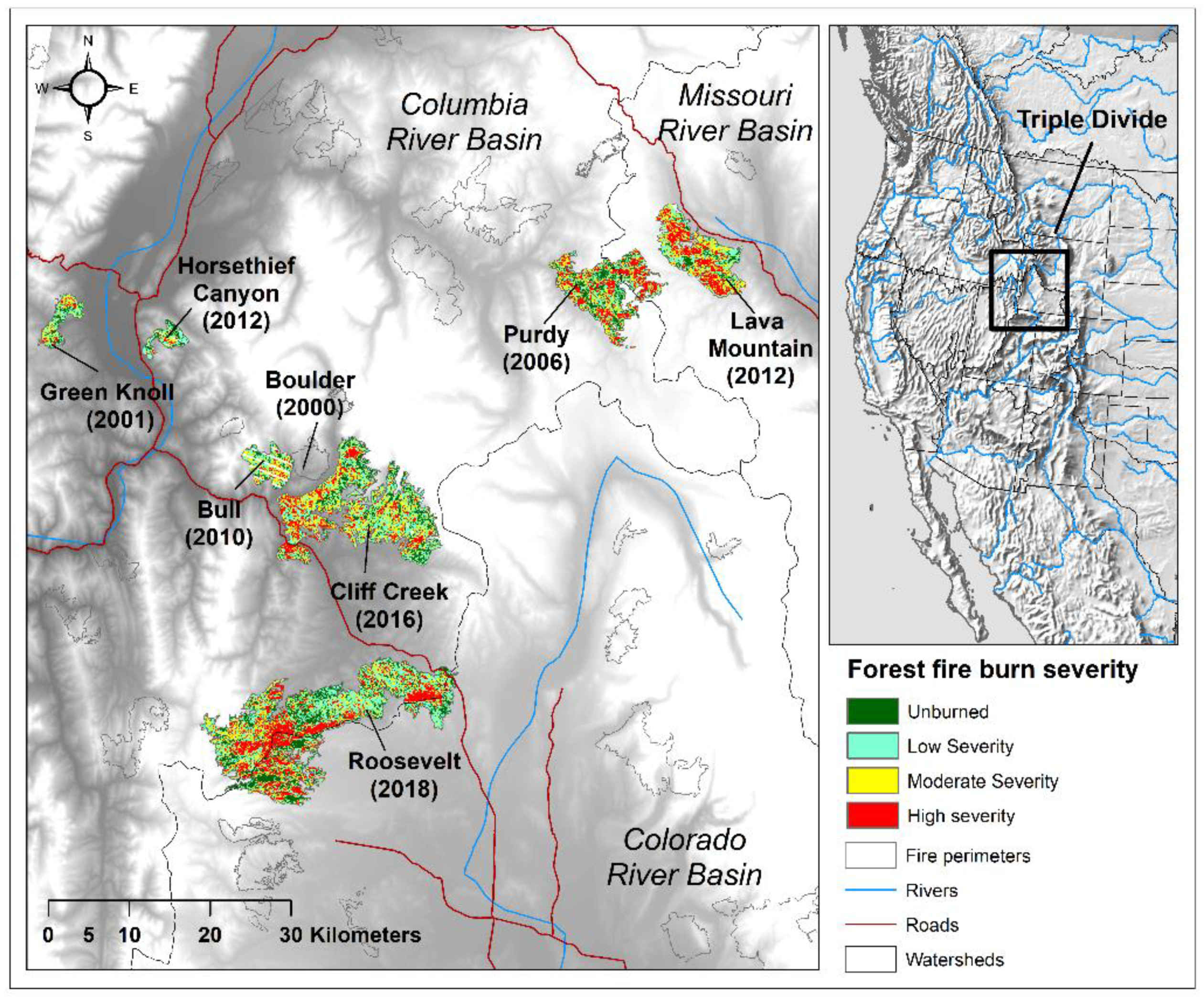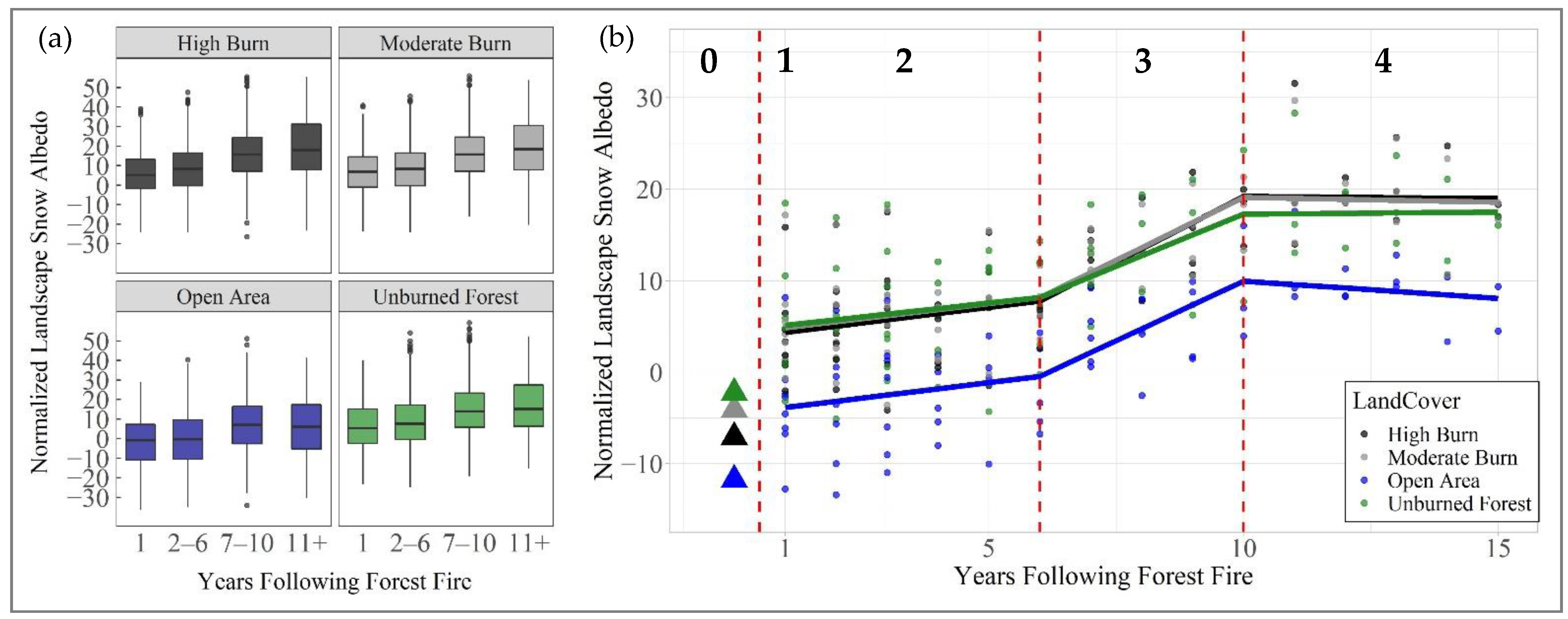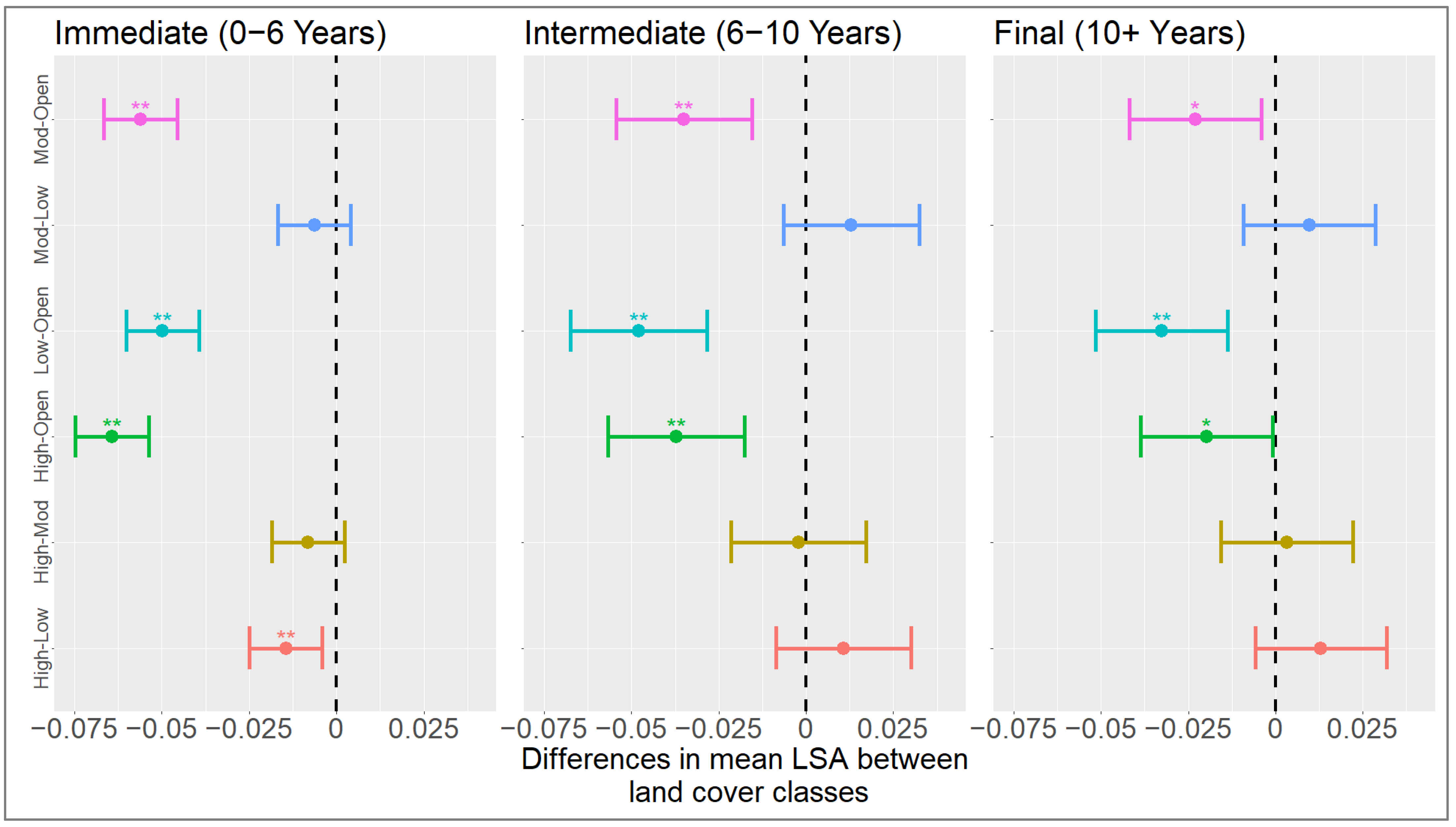Forest Fire Effects on Landscape Snow Albedo Recovery and Decay
Abstract
:1. Introduction
2. Materials and Methods
2.1. Study Area
2.2. Remote Sensing Data
2.3. MODIS Downscale
2.4. SNOTEL Data and Days since Snowfall
2.5. LSA Recovery and Decay Statistical Analysis
3. Results
3.1. Annual Landscape Snow Albedo Recovery following Forest Fire
3.2. Post-Fire Annual Landscape Snow Albedo Recovery
3.3. Post-Fire Burn Severity and Annual Landscape Snow Albedo Recovery
3.4. Post-Fire Daily Landscape Snow Albedo Decay
4. Discussion
4.1. Post-Fire Landscape Snow Albedo Recovery
4.2. Uncertainties in Post-Fire Landscape Snow Albedo Recovery
4.3. Post-Fire Landscape Snow Albedo Decay
4.4. Uncertainties in Post-Fire Landscape Snow Albedo Decay
5. Conclusions
Supplementary Materials
Author Contributions
Funding
Data Availability Statement
Acknowledgments
Conflicts of Interest
References
- Li, D.; Wrzesien, M.L.; Durand, M.; Adam, J.; Lettenmaier, D.P. How Much Runoff Originates as Snow in the Western United States, and How Will That Change in the Future? Geophys. Res. Lett. 2017, 44, 6163–6172. [Google Scholar] [CrossRef] [Green Version]
- Tague, C.; Grant, G. Groundwater Dynamics Mediate Low-Flow Response to Global Warming in Snow-Dominated Alpine Regions. Water Resour. Res. 2009, 45, W07421. [Google Scholar] [CrossRef]
- Buytaert, W.; Cuesta-Camacho, F.; Tobon, C. Potential Impacts of Climate Change on the Environmental Services of Humid Tropical Alpine Regions. Glob. Ecol. Biogeogr. 2011, 20, 19–33. [Google Scholar] [CrossRef]
- Mote, P.W.; Li, S.; Lettenmaier, D.P.; Xiao, M.; Engel, R. Dramatic Declines in Snowpack in the Western US. Npj Clim. Atmos. Sci. 2018, 1, 2. [Google Scholar] [CrossRef] [Green Version]
- Clifton, C.F.; Day, K.T.; Luce, C.H.; Grant, G.E.; Safeeq, M.; Halofsky, J.E.; Staab, B.P. Effects of Climate Change on Hydrology and Water Resources in the Blue Mountains, Oregon, USA. Clim. Serv. 2018, 10, 9–19. [Google Scholar] [CrossRef]
- Mote, P.W.; Hamlet, A.F.; Clark, M.P.; Lettenmaier, D.P. Declining Mountain Snowpack in Western North America. Bull. Am. Meteorol. Soc. 2005, 86, 39–50. [Google Scholar] [CrossRef]
- Pederson, G.; Betancourt, J.; McCabe, G. Regional Patterns and Proximal Causes of the Recent Snowpack Decline in the Rocky Mountains, US. Geophys. Res. Lett. 2013, 40, 1811–1816. [Google Scholar] [CrossRef]
- Safeeq, M.; Grant, G.E.; Lewis, S.L.; Tague, C.L. Coupling Snowpack and Groundwater Dynamics to Interpret Historical Streamflow Trends in the Western United States. Hydrol. Process. 2013, 27, 655–668. [Google Scholar] [CrossRef]
- Barnett, T.P.; Adam, J.C.; Lettenmaier, D.P. Potential Impacts of a Warming Climate on Water Availability in Snow-Dominated Regions. Nature 2005, 438, 303. [Google Scholar] [CrossRef]
- Harpold, A.A. Diverging Sensitivity of Soil Water Stress to Changing Snowmelt Timing in the Western US. Adv. Water Resour. 2016, 92, 116–129. [Google Scholar] [CrossRef] [Green Version]
- Westerling, A.; Hidalgo, H.; Cayan, D.; Swetnam, T. Warming and Earlier Spring Increase Western US Forest Wildfire Activity. Science 2006, 313, 940–943. [Google Scholar] [CrossRef] [PubMed] [Green Version]
- Littell, J.; McKenzie, D.; Peterson, D.; Westerling, A. Climate and Wildfire Area Burned in Western U. S. Ecoprovinces, 1916–2003. Ecol. Appl. 2009, 19, 1003–1021. [Google Scholar] [CrossRef] [PubMed]
- Jolly, W.M.; Cochrane, M.A.; Freeborn, P.H.; Holden, Z.A.; Brown, T.J.; Williamson, G.J.; Bowman, D.M. Climate-Induced Variations in Global Wildfire Danger from 1979 to 2013. Nat. Commun. 2015, 6, 7537. [Google Scholar] [CrossRef]
- Gleason, K.; Nolin, A.; Roth, T. Charred Forests Increase Snowmelt: Effects of Burned Woody Debris and Incoming Solar Radiation on Snow Ablation. Geophys. Res. Lett. 2013, 40, 4654–4661. [Google Scholar] [CrossRef]
- Gleason, K.; Nolin, A. Charred Forests Accelerate Snow Albedo Decay: Parameterizing the Post-Fire Radiative Forcing on Snow for Three Years Following Fire. Hydrol. Process. 2016, 30, 3855–3870. [Google Scholar] [CrossRef]
- Burles, K.; Boon, S. Snowmelt Energy Balance in a Burned Forest Plot, Crowsnest Pass, Alberta, Canada. Hydrol. Process. 2011, 25, 3012–3029. [Google Scholar] [CrossRef]
- Warren, S.G.; Wiscombe, W.J. A Model for the Spectral Albedo of Snow. II: Snow Containing Atmospheric Aerosols. J. Atmos. Sci. 1980, 37, 2734–2745. [Google Scholar] [CrossRef]
- Maxwell, J.D.; Call, A.; Clair, S.B.S. Wildfire and Topography Impacts on Snow Accumulation and Retention in Montane Forests. For. Ecol. Manag. 2019, 432, 256–263. [Google Scholar] [CrossRef]
- Gleason, K.E.; McConnell, J.R.; Arienzo, M.M.; Chellman, N.; Calvin, W.M. Four-Fold Increase in Solar Forcing on Snow in Western US Burned Forests since 1999. Nat. Commun. 2019, 10, 2026. [Google Scholar] [CrossRef]
- Wiscombe, W.J.; Warren, S.G. A Model for the Spectral Albedo of Snow. I: Pure Snow. J. Atmos. Sci. 1980, 37, 2712–2733. [Google Scholar] [CrossRef] [Green Version]
- Dozier, J.; Green, R.O.; Nolin, A.W.; Painter, T.H. Interpretation of Snow Properties from Imaging Spectrometry. Remote Sens. Environ. 2009, 113, S25–S37. [Google Scholar] [CrossRef]
- Grenfell, T.C.; Warren, S.G.; Mullen, P.C. Reflection of Solar Radiation by the Antarctic Snow Surface at Ultraviolet, Visible, and near-Infrared Wavelengths. J. Geophys. Res. Atmos. 1994, 99, 18669–18684. [Google Scholar] [CrossRef]
- Wang, Z.; Zeng, X. Evaluation of Snow Albedo in Land Models for Weather and Climate Studies. J. Appl. Meteorol. Climatol. 2010, 49, 363–380. [Google Scholar] [CrossRef]
- Flanner, M.G.; Zender, C.S. Linking Snowpack Microphysics and Albedo Evolution. J. Geophys. Res. Atmos. 2006, 111. [Google Scholar] [CrossRef] [Green Version]
- O’Neill, A.D.J.; Gray, D.M. Spatial and Temporal Variations of the Albedo of Prairie Snowpack. In The Role of Snow and Ice in Hydrology, Proceedings of the International Symposia on the Role of Snow and Ice in Hydrology, Banff, AB, Canada, 6–20 September 1972; WHO: Geneva, Switzerland; International Association of the Hydrological Sciences: Budapest, Hungary; Unesco: Paris, France, 1973. [Google Scholar]
- Amaral, T.O.; Wake, C.P.; Dibb, J.E.; Burakowski, E.; Stampone, M.L. A Simple Model for Predicting Snow Albedo Decay Using Observations from the Community Collaborative Rain, Hail, and Snow-Albedo (CoCoRAHS-Albedo) Network. J. Glaciol. 2017. [Google Scholar] [CrossRef] [Green Version]
- Painter, T.H.; Skiles, S.M.; Deems, J.S.; Bryant, A.C.; Landry, C.C. Dust Radiative Forcing in Snow of the Upper Colorado River Basin: 1. A 6 Year Record of Energy Balance, Radiation, and Dust Concentrations. Water Resour. Res. 2012, 48, W07521. [Google Scholar] [CrossRef] [Green Version]
- Painter, T.H.; Barrett, A.P.; Landry, C.C.; Neff, J.C.; Cassidy, M.P.; Lawrence, C.R.; McBride, K.E.; Farmer, G.L. Impact of Disturbed Desert Soils on Duration of Mountain Snow Cover. Geophys. Res. Lett. 2007, 34, L12502. [Google Scholar] [CrossRef] [Green Version]
- Singh, S.; Kulkarni, A.; Chaudhary, B. Hyperspectral Analysis of Snow Reflectance to Understand the Effects of Contamination and Grain Size. Ann. Glaciol. 2010, 51, 83–88. [Google Scholar] [CrossRef] [Green Version]
- Lyons, E.A.; Jin, Y.; Randerson, J.T. Changes in Surface Albedo after Fire in Boreal Forest Ecosystems of Interior Alaska Assessed Using MODIS Satellite Observations. J. Geophys. Res. Biogeosci. 2008, 113, G02012. [Google Scholar] [CrossRef] [Green Version]
- Randerson, J.T.; Liu, H.; Flanner, M.G.; Chambers, S.D.; Jin, Y.; Hess, P.G.; Pfister, G.; Mack, M.C.; Treseder, K.K.; Welp, L.R.; et al. The Impact of Boreal Forest Fire on Climate Warming. Science 2006, 314, 1130–1132. [Google Scholar] [CrossRef] [Green Version]
- Burakowski, E.A.; Ollinger, S.V.; Lepine, L.; Schaaf, C.B.; Wang, Z.; Dibb, J.E.; Hollinger, D.Y.; Kim, J.; Erb, A.; Martin, M. Spatial Scaling of Reflectance and Surface Albedo over a Mixed-Use, Temperate Forest Landscape during Snow-Covered Periods. Remote Sens. Environ. 2015, 158, 465–477. [Google Scholar] [CrossRef]
- Brown, R.D.; Robinson, D.A. Northern Hemisphere Spring Snow Cover Variability and Change over 1922–2010 Including an Assessment of Uncertainty. Cryosphere 2011, 5, 219–229. [Google Scholar] [CrossRef] [Green Version]
- Bala, G.; Caldeira, K.; Wickett, M.; Phillips, T.; Lobell, D.; Delire, C.; Mirin, A. Combined Climate and Carbon-Cycle Effects of Large-Scale Deforestation. Proc. Natl. Acad. Sci. USA 2007, 104, 6550–6555. [Google Scholar] [CrossRef] [PubMed] [Green Version]
- Bonan, G.B. Forests and Climate Change: Forcings, Feedbacks, and the Climate Benefits of Forests. Science 2008, 320, 1444–1449. [Google Scholar] [CrossRef] [Green Version]
- Jin, Y.; Randerson, J.T.; Goulden, M.L.; Goetz, S.J. Post-Fire Changes in Net Shortwave Radiation along a Latitudinal Gradient in Boreal North America. Geophys. Res. Lett. 2012, 39, L13403. [Google Scholar] [CrossRef] [Green Version]
- Bair, E.H.; Rittger, K.; Skiles, S.M.; Dozier, J. An Examination of Snow Albedo Estimates from MODIS and Their Impact on Snow Water Equivalent Reconstruction. Water Resour. Res. 2019, 55, 7826–7842. [Google Scholar] [CrossRef]
- Ueyama, M.; Ichii, K.; Iwata, H.; Euskirchen, E.S.; Zona, D.; Rocha, A.V.; Harazono, Y.; Iwama, C.; Nakai, T.; Oechel, W.C. Change in Surface Energy Balance in Alaska Due to Fire and Spring Warming, Based on Upscaling Eddy Covariance Measurements. J. Geophys. Res. Biogeosci. 2014, 119, 1947–1969. [Google Scholar] [CrossRef]
- Webster, C.; Jonas, T. Influence of Canopy Shading and Snow Coverage on Effective Albedo in a Snow-Dominated Evergreen Needleleaf Forest. Remote Sens. Environ. 2018, 214, 48–58. [Google Scholar] [CrossRef]
- Youngblood, A.; Grace, J.B.; McIver, J.D. Delayed Conifer Mortality after Fuel Reduction Treatments: Interactive Effects of Fuel, Fire Intensity, and Bark Beetles. Ecol. Appl. 2009, 19, 321–337. [Google Scholar] [CrossRef] [Green Version]
- Fettig, C.J.; McKelvey, S.R.; Cluck, D.R.; Smith, S.L.; Otrosina, W.J. Effects of Prescribed Fire and Season of Burn on Direct and Indirect Levels of Tree Mortality in Ponderosa and Jeffrey Pine Forests in California, USA. For. Ecol. Manag. 2010, 260, 207–218. [Google Scholar] [CrossRef]
- Das, A.; Battles, J.; Stephenson, N.L.; van Mantgem, P.J. The Contribution of Competition to Tree Mortality in Old-Growth Coniferous Forests. For. Ecol. Manag. 2011, 261, 1203–1213. [Google Scholar] [CrossRef]
- Eidenshink, J.; Schwind, B.; Brewer, K.; Zhu, Z.; Quayle, B.; Howard, S. A Project for Monitoring Trends in Burn Severity. Fire Ecol. 2007, 3, 3–21. [Google Scholar] [CrossRef]
- Davis, K.T.; Dobrowski, S.Z.; Higuera, P.E.; Holden, Z.A.; Veblen, T.T.; Rother, M.T.; Parks, S.A.; Sala, A.; Maneta, M.P. Wildfires and Climate Change Push Low-Elevation Forests across a Critical Climate Threshold for Tree Regeneration. Proc. Natl. Acad. Sci. USA 2019, 116, 6193–6198. [Google Scholar] [CrossRef] [Green Version]
- Jin, Y.; Randerson, J.T.; Goetz, S.J.; Beck, P.S.; Loranty, M.M.; Goulden, M.L. The Influence of Burn Severity on Postfire Vegetation Recovery and Albedo Change during Early Succession in North American Boreal Forests. J. Geophys. Res. Biogeosci. 2012, 117, G01036. [Google Scholar] [CrossRef]
- Coppoletta, M.; Merriam, K.E.; Collins, B.M. Post-Fire Vegetation and Fuel Development Influences Fire Severity Patterns in Reburns. Ecol. Appl. 2016, 26, 686–699. [Google Scholar] [CrossRef]
- Smoot, E.E.; Gleason, K.E. Forest Fires Reduce Snow-Water Storage and Advance the Timing of Snowmelt across the Western US. Water 2021, 13, 3533. [Google Scholar] [CrossRef]
- Hood, S.M.; Varner, J.M.; Van Mantgem, P.; Cansler, C.A. Fire and Tree Death: Understanding and Improving Modeling of Fire-Induced Tree Mortality. Environ. Res. Lett. 2018, 13, 113004. [Google Scholar] [CrossRef]
- Nolin, A.; Daly, C. Mapping “at Risk” Snow in the Pacific Northwest. J. Hydrometeorol. 2006, 7, 1164–1171. [Google Scholar] [CrossRef]
- Barnett, T.P.; Pierce, D.W.; Hidalgo, H.G.; Bonfils, C.; Santer, B.D.; Das, T.; Bala, G.; Wood, A.W.; Nozawa, T.; Mirin, A.A. Human-Induced Changes in the Hydrology of the Western United States. Science 2008, 319, 1080–1083. [Google Scholar] [CrossRef] [Green Version]
- Westerling, A.; Bryant, B.; Preisler, H.; Holmes, T.; Hidalgo, H.; Das, T.; Shrestha, S. Climate Change and Growth Scenarios for California Wildfire. Clim. Chang. 2011, 109, 445–463. [Google Scholar] [CrossRef]
- Serreze, M.; Clark, M.; Armstrong, R.; McGinnis, D.; Pulwarty, R. Characteristics of the Western United States Snowpack from Snowpack Telemetry (SNOTEL) Data. Water Resour. Res. 1999, 35, 2145–2160. [Google Scholar] [CrossRef] [Green Version]
- Hall, D.; Riggs, G.; Salomonson, V. MODIS/Terra Snow Cover Daily L3 Global 500 m Grid, Version 6; NASA National Snow and Ice Data Center Distributed Active Archive Center: Boulder, CO, USA, 2016. [Google Scholar]
- Keevallik, S.; Tooming, H. Relationships between Surface Albedo and Spring Heat Accumulation. Tellus A 1996, 48, 727–732. [Google Scholar] [CrossRef] [Green Version]
- Wang, K.; Zhang, L.; Qiu, Y.; Ji, L.; Tian, F.; Wang, C.; Wang, Z. Snow Effects on Alpine Vegetation in the Qinghai-Tibetan Plateau. Int. J. Digit. Earth 2015, 8, 58–75. [Google Scholar] [CrossRef]
- Klein, A.G.; Stroeve, J. Development and Validation of a Snow Albedo Algorithm for the MODIS Instrument. Ann. Glaciol. 2002, 34, 45–52. [Google Scholar] [CrossRef] [Green Version]
- DiMiceli, C.; Townshend, J.; Carroll, M.; Sohlberg, R. Evolution of the Representation of Global Vegetation by Vegetation Continuous Fields. Remote Sens. Environ. 2021, 254, 112271. [Google Scholar] [CrossRef]
- Homer, C.; Dewitz, J.; Yang, L.; Jin, S.; Danielson, P.; Xian, G.; Coulston, J.; Herold, N.; Wickham, J.; Megown, K. Completion of the 2011 National Land Cover Database for the Conterminous United States–Representing a Decade of Land Cover Change Information. Photogramm. Eng. Remote Sens. 2015, 81, 345–354. [Google Scholar]
- Klein, A.G.; Barnett, A.C. Validation of Daily MODIS Snow Cover Maps of the Upper Rio Grande River Basin for the 2000–2001 Snow Year. Remote Sens. Environ. 2003, 86, 162–176. [Google Scholar] [CrossRef]
- Liang, X.-Z.; Kunkel, K.E.; Meehl, G.A.; Jones, R.G.; Wang, J.X. Regional Climate Models Downscaling Analysis of General Circulation Models Present Climate Biases Propagation into Future Change Projections. Geophys. Res. Lett. 2008, 35, L08709. [Google Scholar] [CrossRef] [Green Version]
- Chen, J.; Brissette, F.P.; Zhang, X.J.; Chen, H.; Guo, S.; Zhao, Y. Bias Correcting Climate Model Multi-Member Ensembles to Assess Climate Change Impacts on Hydrology. Clim. Chang. 2019, 153, 361–377. [Google Scholar] [CrossRef]
- R Development Core Team. R: A Language and Environment for Statistical Computing; R Foundation for Statistical Computing: Vienna, Austria, 2016. [Google Scholar]
- ESRI ArcGIS Desktop: Release 10.4. 2015.
- Bond-Lamberty, B.; Gower, S.T. Decomposition and Fragmentation of Coarse Woody Debris: Re-Visiting a Boreal Black Spruce Chronosequence. Ecosystems 2008, 11, 831–840. [Google Scholar] [CrossRef]
- Kemp, K.B.; Higuera, P.E.; Morgan, P.; Abatzoglou, J.T. Climate Will Increasingly Determine Post-Fire Tree Regeneration Success in Low-Elevation Forests, Northern Rockies, USA. Ecosphere 2019, 10, e02568. [Google Scholar] [CrossRef]
- Coops, N.C.; Shang, C.; Wulder, M.A.; White, J.C.; Hermosilla, T. Change in Forest Condition: Characterizing Non-Stand Replacing Disturbances Using Time Series Satellite Imagery. For. Ecol. Manag. 2020, 474, 118370. [Google Scholar] [CrossRef]
- Wang, Z.; Erb, A.M.; Schaaf, C.B.; Sun, Q.; Liu, Y.; Yang, Y.; Shuai, Y.; Casey, K.A.; Román, M.O. Early Spring Post-Fire Snow Albedo Dynamics in High Latitude Boreal Forests Using Landsat-8 OLI Data. Remote Sens. Environ. 2016, 185, 71–83. [Google Scholar] [CrossRef] [Green Version]
- Kitzberger, T.; Falk, D.A.; Westerling, A.L.; Swetnam, T.W. Direct and Indirect Climate Controls Predict Heterogeneous Early-Mid 21st Century Wildfire Burned Area across Western and Boreal North America. PLoS ONE 2017, 12, e0188486. [Google Scholar]
- Abatzoglou, J.T.; Williams, A.P.; Barbero, R. Global Emergence of Anthropogenic Climate Change in Fire Weather Indices. Geophys. Res. Lett. 2019, 46, 326–336. [Google Scholar] [CrossRef] [Green Version]






| Fire Name | Ignition Date | Burned Area (km2) | Elevation (m) | Major River System | Average Burn Severity |
|---|---|---|---|---|---|
| Boulder | 31 July 2000 | 15.2 | 2240 | Columbia | Moderate |
| Green Knoll | 22 July 2001 | 15.3 | 2144 | Columbia | Moderate |
| Purdy | 4 August 2006 | 72.2 | 2804 | Columbia /Missouri | Moderate |
| Bull | 23 July 2010 | 22.2 | 2164 | Columbia | Moderate |
| Horsethief Canyon | 8 September 2012 | 11.3 | 2286 | Columbia | Low |
| Lava Mountain | 11 July 2016 | 59.3 | 2432 | Missouri | Moderate |
| Cliff Creek | 17 July 2016 | 146.2 | 2225 | Columbia | Moderate |
| Roosevelt | 15 September 2018 | 248.9 | 2438 | Columbia/Colorado | Moderate |
| Forest Fire Name (Year Burned) | Pre-Fire Count (n) | Pre-Fire Mean | Pre-Fire sd | Post-Fire Count (n) | Post-Fire Mean | Post-Fire sd | Mean Difference | Percent Increase |
|---|---|---|---|---|---|---|---|---|
| Boulder (2000) | 99 | 36.83 | 9.21 | 4594 | 54.5 | 16.14 | 17.67 *** | 39% |
| Green Knoll (2001) | 341 | 30.94 | 9.39 | 3742 | 44.28 | 13.18 | 13.34 *** | 35% |
| Purdy (2006) | 1629 | 33.24 | 9.72 | 2986 | 43.96 | 10.85 | 10.72 *** | 28% |
| Bull (2010) | 2498 | 37.64 | 11.99 | 1881 | 45.71 | 12.52 | 8.07 *** | 19% |
| Horsethief Canyon (2012) | 2779 | 41.82 | 12.67 | 1405 | 45.49 | 12.95 | 3.67 *** | 8.40% |
| Lava Mountain (2016) | 3949 | 31.85 | 9.69 | 698 | 45.16 | 10.06 | 13.31 *** | 35% |
| Cliff Creek (2016) | 4141 | 40.84 | 12.83 | 610 | 47.92 | 12.39 | 7.08 *** | 16% |
| Roosevelt (2018) | 4740 | 43.16 | 13.86 | 257 | 50.33 | 12.74 | 7.17 *** | 15% |
| Pre- vs. Post-Fire Comparisons | Percent Increase | Post-Fire Comparisons within Burn Perimeter | Percent Increase |
|---|---|---|---|
| high | 44% *** | open-unburned | 8.7% *** |
| moderate | 36% *** | open-high | 8.4% *** |
| unburned | 32% *** | open-moderate | 8.1% *** |
| open | 22% *** | unburned-high | 0.3% |
| moderate-high | 0.4% | ||
| unburned-moderate | 0.7% |
Publisher’s Note: MDPI stays neutral with regard to jurisdictional claims in published maps and institutional affiliations. |
© 2022 by the authors. Licensee MDPI, Basel, Switzerland. This article is an open access article distributed under the terms and conditions of the Creative Commons Attribution (CC BY) license (https://creativecommons.org/licenses/by/4.0/).
Share and Cite
Gersh, M.; Gleason, K.E.; Surunis, A. Forest Fire Effects on Landscape Snow Albedo Recovery and Decay. Remote Sens. 2022, 14, 4079. https://doi.org/10.3390/rs14164079
Gersh M, Gleason KE, Surunis A. Forest Fire Effects on Landscape Snow Albedo Recovery and Decay. Remote Sensing. 2022; 14(16):4079. https://doi.org/10.3390/rs14164079
Chicago/Turabian StyleGersh, Max, Kelly E. Gleason, and Anton Surunis. 2022. "Forest Fire Effects on Landscape Snow Albedo Recovery and Decay" Remote Sensing 14, no. 16: 4079. https://doi.org/10.3390/rs14164079
APA StyleGersh, M., Gleason, K. E., & Surunis, A. (2022). Forest Fire Effects on Landscape Snow Albedo Recovery and Decay. Remote Sensing, 14(16), 4079. https://doi.org/10.3390/rs14164079






